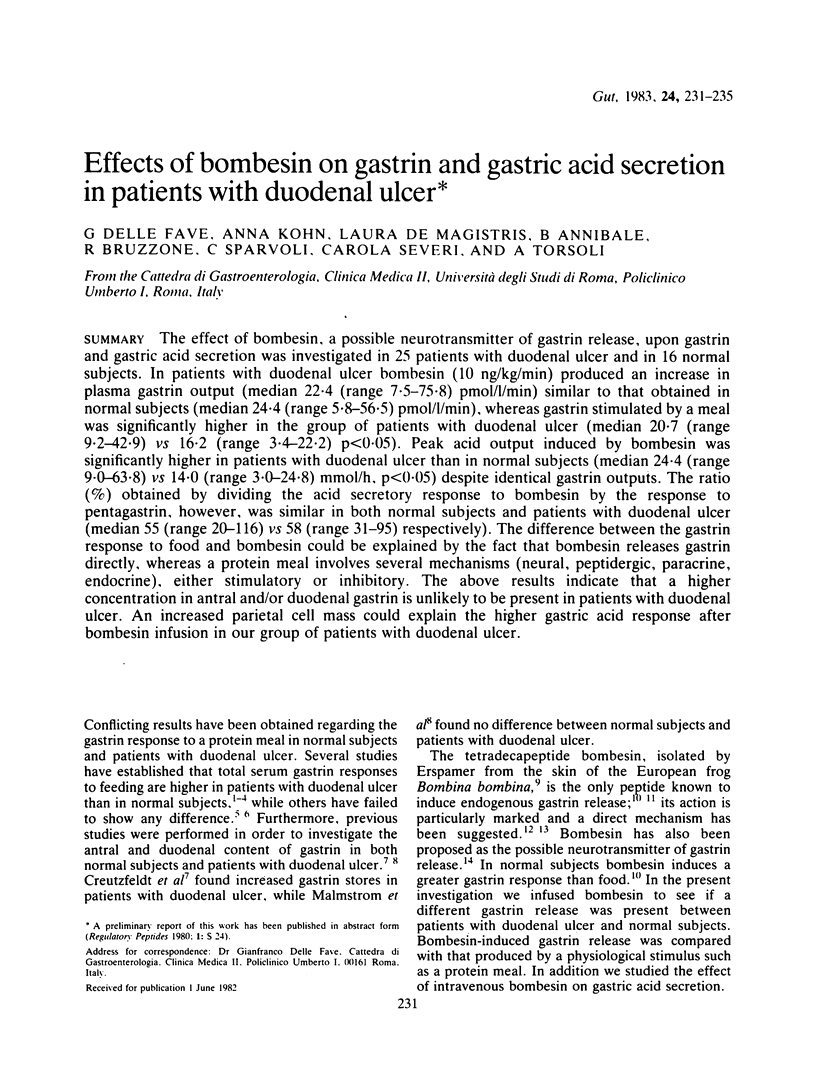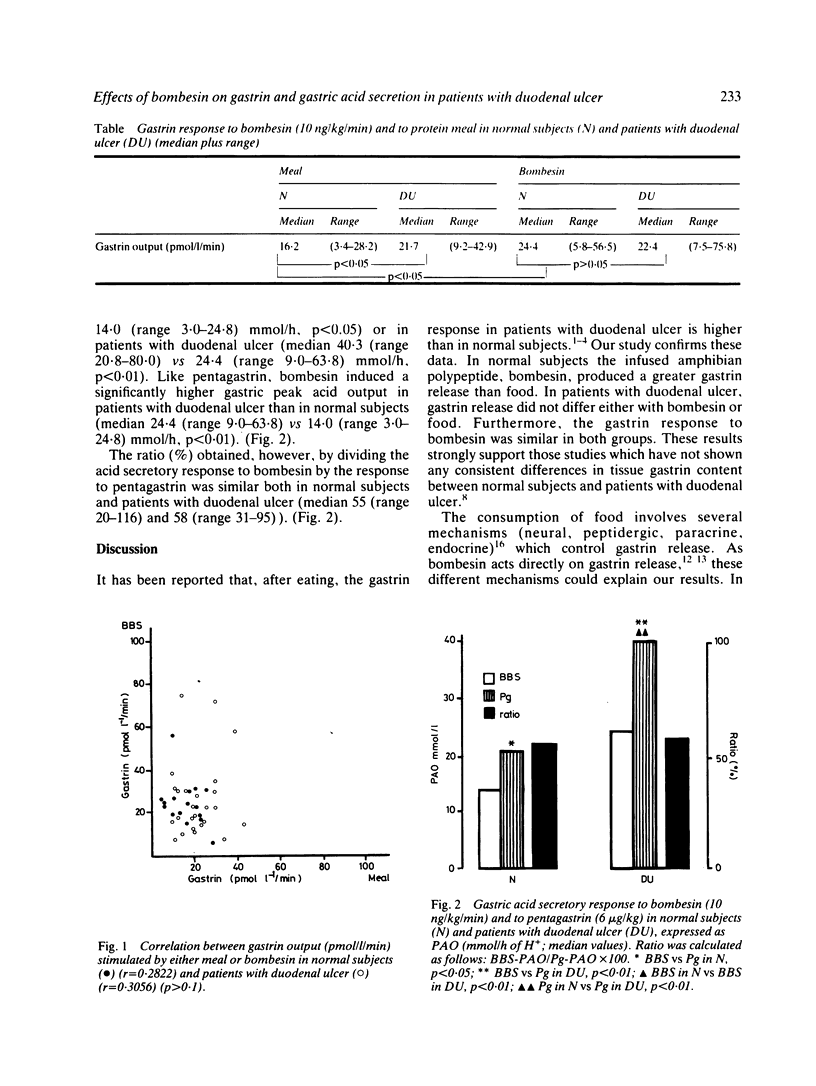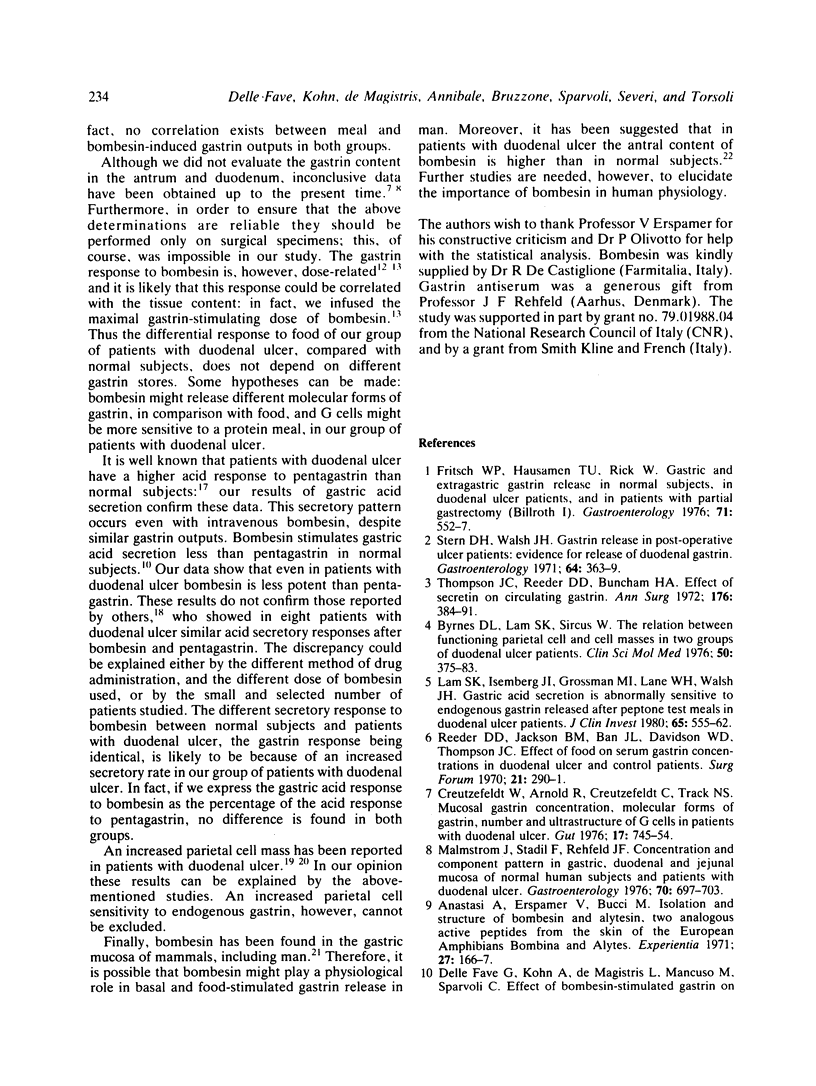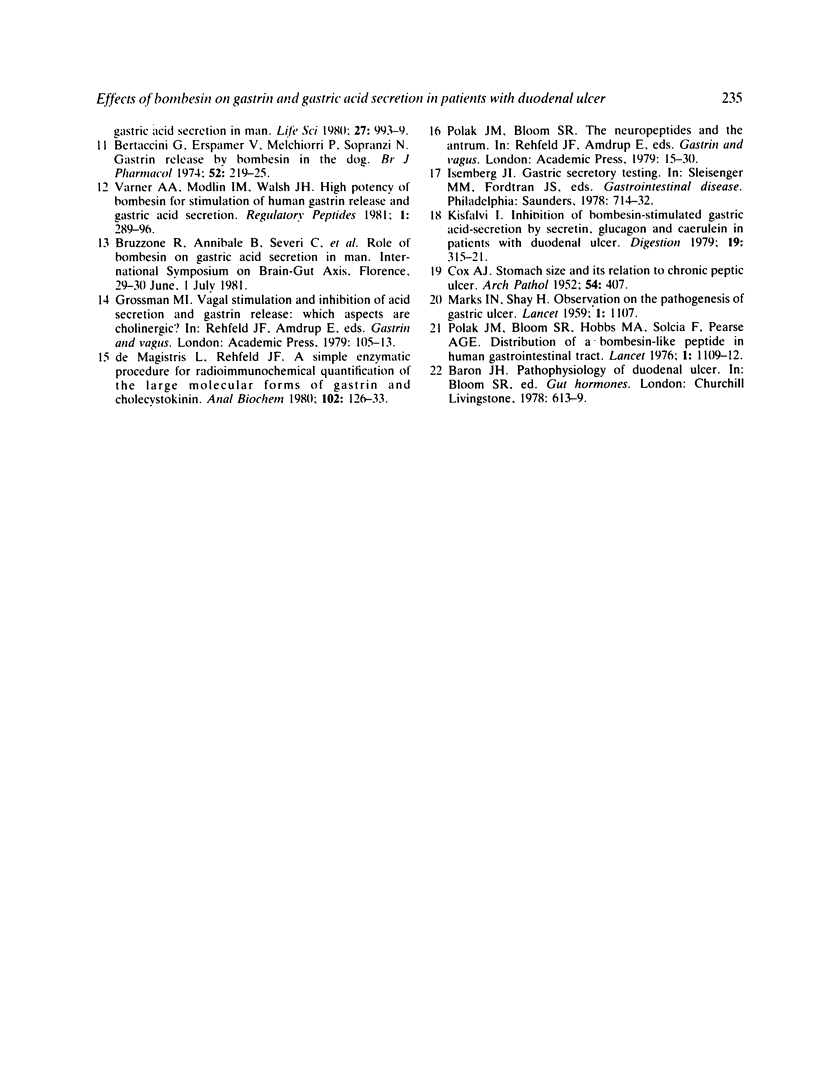Abstract
The effect of bombesin, a possible neurotransmitter of gastrin release, upon gastrin and gastric acid secretion was investigated in 25 patients with duodenal ulcer and in 16 normal subjects. In patients with duodenal ulcer bombesin (10 ng/kg/min) produced an increase in plasma gastrin output (median 22·4 (range 7·5-75·8) pmol/l/min) similar to that obtained in normal subjects (median 24·4 (range 5·8-56·5) pmol/l/min), whereas gastrin stimulated by a meal was significantly higher in the group of patients with duodenal ulcer (median 20·7 (range 9·2-42·9) vs 16·2 (range 3·4-22·2) p<0·05). Peak acid output induced by bombesin was significantly higher in patients with duodenal ulcer than in normal subjects (median 24·4 (range 9·0-63·8) vs 14·0 (range 3·0-24·8) mmol/h, p<0·05) despite identical gastrin outputs. The ratio (%) obtained by dividing the acid secretory response to bombesin by the response to pentagastrin, however, was similar in both normal subjects and patients with duodenal ulcer (median 55 (range 20-116) vs 58 (range 31-95) respectively). The difference between the gastrin response to food and bombesin could be explained by the fact that bombesin releases gastrin directly, whereas a protein meal involves several mechanisms (neural, peptidergic, paracrine, endocrine), either stimulatory or inhibitory. The above results indicate that a higher concentration in antral and/or duodenal gastrin is unlikely to be present in patients with duodenal ulcer. An increased parietal cell mass could explain the higher gastric acid response after bombesin infusion in our group of patients with duodenal ulcer.
Full text
PDF




Selected References
These references are in PubMed. This may not be the complete list of references from this article.
- Anastasi A., Erspamer V., Bucci M. Isolation and structure of bombesin and alytesin, 2 analogous active peptides from the skin of the European amphibians Bombina and Alytes. Experientia. 1971 Feb 15;27(2):166–167. doi: 10.1007/BF02145873. [DOI] [PubMed] [Google Scholar]
- Byrnes D. J., Lam S. K., Sircus W. The relation between functioning parietal cell and gastrin cell masses in two groups of duodenal ulcer patients. Clin Sci Mol Med. 1976 May;50(5):375–383. doi: 10.1042/cs0500375. [DOI] [PubMed] [Google Scholar]
- COX A. J. Stomach size and its relation to chronic peptic ulcer. AMA Arch Pathol. 1952 Nov;54(5):407–422. [PubMed] [Google Scholar]
- Creutzfeldt W., Arnold R., Creutzfeldt C., Track N. S. Mucosal gastrin concentration, molecular forms of gastrin, number and ultrastructure of G-cells in patients with duodenal ulcer. Gut. 1976 Oct;17(10):745–754. doi: 10.1136/gut.17.10.745. [DOI] [PMC free article] [PubMed] [Google Scholar]
- Delle Fave G., Kohn A., de Magistris L., Mancuso M., Sparvoli C. Effect of bombesin-stimulated gastrin on gastric acid secretion in man. Life Sci. 1980 Sep 15;27(11):993–999. doi: 10.1016/0024-3205(80)90110-1. [DOI] [PubMed] [Google Scholar]
- Fritsch W. P., Hausamen T. U., Rick W. Gastric and extragastric gastrin release in normal subjects in duodenal ulcer patients, and in patients with partial gastrectomy (Billroth I). Gastroenterology. 1976 Oct;71(4):552–557. [PubMed] [Google Scholar]
- Kisfalvi I. Inhibition of bombesin-stimulated gastric acid secretion by secretin, glucagon and caerulein in patients with duodenal ulcer. Digestion. 1979;19(5):315–321. doi: 10.1159/000198377. [DOI] [PubMed] [Google Scholar]
- Lam S. K., Isenberg J. I., Grossman M. I., Lane W. H., Walsh J. H. Gastric acid secretion is abnormally sensitive to endogenous gastrin released after peptone test meals in duodenal ulcer patients. J Clin Invest. 1980 Feb;65(2):555–562. doi: 10.1172/JCI109699. [DOI] [PMC free article] [PubMed] [Google Scholar]
- MARKS I. N., SHAY H. Observations on the pathogenesis of gastric ulcer. Lancet. 1959 May 30;1(7083):1107–1111. doi: 10.1016/s0140-6736(59)90702-0. [DOI] [PubMed] [Google Scholar]
- Malstrom J., Stadil F., Rehfeld J. F. Gastrins in tissue. Concentration and component pattern in gastric, duodenal, and jejunal mucosa of normal human subjects and patients with duodenal ulcer. Gastroenterology. 1976 May;70(5 PT1):697–703. [PubMed] [Google Scholar]
- Polak J. M., Bloom S. R., Hobbs S., Solcia E., Pearse A. G. Distribution of a bombesin-like peptide in human gastrointestinal tract. Lancet. 1976 May 22;1(7969):1109–1110. doi: 10.1016/s0140-6736(76)90068-4. [DOI] [PubMed] [Google Scholar]
- Reeder D. D., Jackson B. M., Ban J. L., Davidson W. D., Thompson J. C. Effect of food on serum gastrin concentrations in duodenal ulcer and control patients. Surg Forum. 1970;21:290–291. [PubMed] [Google Scholar]
- Stern D. H., Walsh J. H. Gastrin release in postoperative ulcer patients: evidence for release of duodenal gastrin. Gastroenterology. 1973 Mar;64(3):363–369. [PubMed] [Google Scholar]
- Thompson J. C., Reeder D. D., Bunchman H. H., Becker H. D., Brandt E. N., Jr Effect of secretin on circulating gastrin. Ann Surg. 1972 Sep;176(3):384–393. doi: 10.1097/00000658-197209000-00014. [DOI] [PMC free article] [PubMed] [Google Scholar]
- de Magistris L., Rehfeld J. F. A simple enzymatic procedure for radioimmunochemical quantitation of the large molecular forms of gastrin and cholecystokinin. Anal Biochem. 1980 Feb;102(1):126–133. doi: 10.1016/0003-2697(80)90327-9. [DOI] [PubMed] [Google Scholar]


